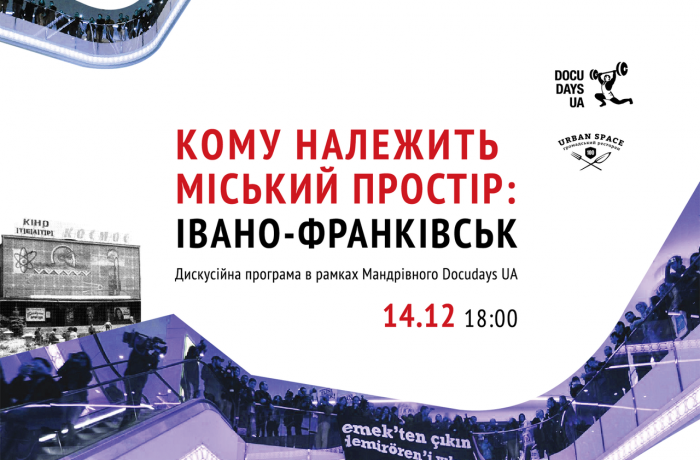Who Owns the Urban Space: Ivano-Frankivsk
Who Owns the Urban Space: Ivano-Frankivsk

This year, the program of the Traveling Docudays UA festival includes the film Audience Emancipated: The Struggle for the Emek Movie Theater. The history of Istanbul protests is not just a struggle for an iconic place which is important for the citizens. These protests were political, in a wider sense, because they were concerned with the question, Who owns the urban space? They inspired us to start a conversation about the Ukrainian context. By involving local experts, artists, urban researchers, and activists in the discussion, we want to study how public spaces develop in Ukrainian cities, and who influences the changes in public space.
On December 14, at 6 p.m., in Ivano-Frankivsk, we invite you to the lecture by the art critic Yevhenia Moliar (Kyiv) and the screening of the film Audience Emancipated: The Struggle for the Emek Movie Theater.
Location: Urban Space 100 (19 Hrushevskoho str.)
THE INFRASTRUCTURAL HERITAGE OF THE SOVIET PERIOD
A lecture by the art critic Yevhenia Moliar (Kyiv) about the experience of revitalization of film theaters by the initiative DE NE DE
In the Soviet period, art and education were completely subservient to the state ideology. Appropriate conditions were created to develop and promote culture as the messenger of ideology: networks of cultural institutions, film theaters and houses of culture appeared in practically every town and village. Today, a considerable number of these buildings are in the state of disrepair. These are public spaces which were, in their time, deprived of the possibility of free gatherings and politically unengaged expression of citizens, because they were strictly regulated. In the Soviet time, such functions of public spaces as leisure and community building were instrumentalized by the state for the sake of propaganda and control over citizens.
In the conditions of decommunization, there is a chance to deconstruct the “Soviet” instead of unifying and condemning it as a whole. Soviet public spaces are not bad in and of themselves, because they look “Sovietish” and were created in the Soviet period. What was negative in this case was the dictative ideological influence on the functioning of such buildings as houses of culture and film theater. That whas what turned them into an instrument of propaganda.
Many cultural infrastructure buildings remained in Ukraine since the Soviet times, and they can and must turn from “quasi-public spaces” (like in the Soviet period) into contemporary cultural and artistic centers.
About the DE NE DE Initiative
Yevhenia Moliar is a participant of the self-organized initiative DE NE DE which studies the cultural and infrastructural heritage of the Soviet period. By focusing on the urban transformations during decommunization, DE NE DE offers a critical reconsideration of the Soviet heritage.
In 2015, the self-organized art initiative DE NE DE started a long-term project of the Above God residences in the semi-abandoned film theater Russia in Vinnytsia.
In 2017, the DE NE DE initiative is working to actualize the non-functioning film theaters in different regions of Ukraine. On the walls and the locked doors of town film theaters, DE NE DE screens films by contemporary Ukrainian directors. They have already organized screenings in Tatarbunary, Ismail, Bilhorod-Dnistrovskyi, Podilsk, Zhytomyr. This way, they remind the audience about the original function of these buildings and about the importance of preserving and revitalizing them.
FREE ENTRY












